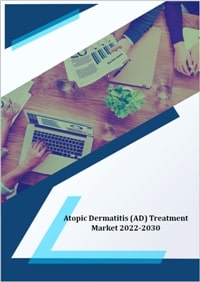
Atopic dermatitis is also known as atopic eczema, it is a chronic inflammatory skin disease characterized by itchy skin lesions and rashes. Atopic Dermatitis treatment market is rapidly growing due to factors such as growing prevalence of AD, significant unmet needs, promising pipeline molecules would fuel the market growth of atopic dermatitis treatment.
The report titled “Atopic Dermatitis (AD) Treatment Market - Growth, Future Prospects and Competitive Analysis, 2023–2030” offers strategic insights into the overall Atopic Dermatitis (AD) treatment market along with the market size and estimates for the duration 2020 to 2030. The research study covers in-depth analysis of market segments based on drug type and different geographical regions.
Along with quantitative information, qualitative information sets and assessment tools are provided in this study for better analysis of the overall market scenario and future prospects. Information such as market inclination insights and drivers, challenges and opportunities assists the readers for understanding the ongoing trends in the global AD treatment market. Pipeline analysis of AD treatment molecule and global epidemiology data have been included in report. Tools such as market positioning of key players and attractive investment proposition provide the readers with insights on the competitive scenario of the global AD treatment market. This report concludes with company profiles section that highlights major information about the key players engaged in global AD treatment market. In-depth competitive environment analysis and historical years (2020) market size data are also provided in the report.
Atopic dermatitis (AD) also referred as atopic eczema, is an inflammatory disease of the skin, in which the skin becomes extremely itchy and inflamed, causing redness, swelling, vesicle formation. There is no cure for AD but medications are used to relief itching and prevent new outbreaks. It is studied that, currently anti-inflammatory agents held largest market share in global atopic dermatitis treatment market. Among considered anti-inflammatory segment corticosteroids is major revenue generating segment as these are preferred as first line treatment after failure of skin care and moisturizers due to its effectiveness. It is estimated that new product launch would drive the AD treatment market growth during forecast period. Pipeline molecules such as ABT-494, apremilast, LY-3009104, GSK-2894512, REGN-668, GBR-830, MEDI-9929, nemolizumab, OPA-15406, PF-04965842, secukinumab and tralokinumab are expected to show AD treatment market growth during forecast period. However, adverse effects associated with medication and poor treatment compliance in some countries may negatively impacting AD treatment market growth.
Atopic dermatitis (AD) is a chronic, inflammatory disease of the skin characterized by dry, itchy skin. The prevalence of AD is approximately 15 - 20% in children and 1-3% of adults worldwide and the incidence has increased by 2 to 3 folds during the past decades in industrialized countries. Among the considered geographical segment, North America was major revenue generating segment in the base year 2016. Some factors such as increase in prevalence of AD, higher treatment awareness, swift adoption of novel medications, better reimbursement policies in healthcare systems are the prime contributors of the dominance in North America Atopic dermatitis market. Expenditure on healthcare is highest in the United States as compared to other nations is another factor contributing growth of AD treatment market. According to American Academy of Dermatology approximately 10 to 20 percent of childrens in the United States develop atopic dermatitis; AD affects more than 28 million people of all ages in the United States alone. It is estimated that, Asia Pacific will show highest AD treatment market growth during forecast period due to increasing healthcare awareness among general patient population, developing economic conditions, growing number of investment and partnering of key player with local manufacturers.
Historical & Forecast Period
This study report represents analysis of each segment from 2022 to 2032 considering 2023 as the base year. Compounded Annual Growth Rate (CAGR) for each of the respective segments estimated for the forecast period of 2024 to 2032.
The current report comprises of quantitative market estimations for each micro market for every geographical region and qualitative market analysis such as micro and macro environment analysis, market trends, competitive intelligence, segment analysis, porters five force model, top winning strategies, top investment markets, emerging trends and technological analysis, case studies, strategic conclusions and recommendations and other key market insights.
Research Methodology
The complete research study was conducted in three phases, namely: secondary research, primary research, and expert panel review. key data point that enables the estimation of Atopic Dermatitis (AD) Treatment market are as follows:
Market forecast was performed through proprietary software that analyzes various qualitative and quantitative factors. Growth rate and CAGR were estimated through intensive secondary and primary research. Data triangulation across various data points provides accuracy across various analyzed market segments in the report. Application of both top down and bottom-up approach for validation of market estimation assures logical, methodical and mathematical consistency of the quantitative data.
| ATTRIBUTE | DETAILS |
|---|---|
| Research Period | 2022-2032 |
| Base Year | 2023 |
| Forecast Period | 2024-2032 |
| Historical Year | 2022 |
| Unit | USD Million |
| Segmentation | |
Drug
| |
|
Region Segment (2022-2032; US$ Million)
|
Key questions answered in this report